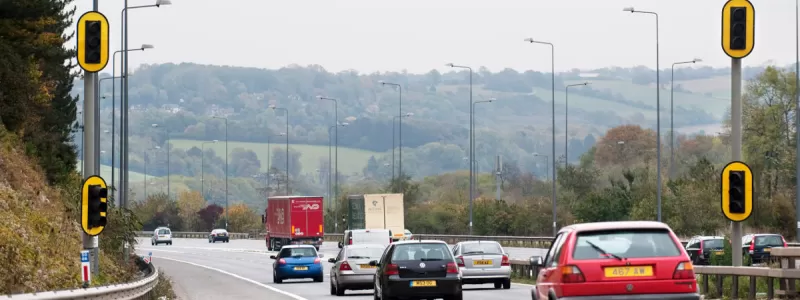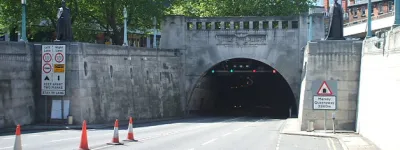There was a bit of a stir when Highways England announced an "innovative pilot project" to install traffic lights on a motorway sliproad. Why are they doing that? And how much of this is new at all?
The front-page headline in the Times was "Traffic lights on motorway sliproads to cut congestion". The Independent reported that "one of Britain’s busiest motorways is set to be fitted with traffic lights in a bid to ease congestion", while Auto Express announced that traffic lights are to be "introduced for the first time on UK motorways". They're referring to work that's about to start at Croft Interchange near Warrington, the junction of the M6 and M62.
We'll look at whether this really is the first time traffic lights have been introduced on UK motorways in a moment. But first, we should probably ask why you'd want to do such a thing in the first place.
Why would you put traffic lights on a motorway?
Ask anyone what is the point of a motorway and they'll tell you the answer. It's obvious. Motorways let large volumes of traffic move uninterrupted at high speed over long distances. Unlike ordinary roads, there's no roundabouts, no Give Way lines, no other traffic crossing your path, no access points to private property, no zebra crossings, no combine harvesters, no diving, no splashing, no heavy petting... and no traffic lights.
So it sometimes seems a bit odd that, worldwide, traffic lights do get installed on sliproads leading to motorways. It's called ramp metering. The name should tell you it's an American term (what they call a ramp we call a sliproad) because it was first tried in the US, and the point of it is to manage the rate at which traffic joins the motorway. If too many vehicles try to merge all at the same time, it can slow down the mainline of the motorway, causing waves of brake lights and stop-start jams - a problem that often affects motorways in the rush hour on the approach to towns and cities.
Ramp metering involves a set of traffic lights at the end of the sliproad, just before it merges with the motorway, which are activated in heavy traffic and cycle rapidly between red and green to allow one or two vehicles to proceed in each lane at a time, creating a steady trickle onto the motorway that will not disrupt the flow. In some advanced schemes, sensors watch for queues at the entrance to the sliproad and can let traffic join more quickly if the queue risks blocking up the junction, and can even link nearby junctions so that some can allow more traffic through than others to even out delays.
What Highways England are talking about is a new scheme to install ramp metering signals on the sliproad that allows traffic from the northbound M6 to join the eastbound M62.
So, let's get this straight. Are these going to be the first traffic lights used for ramp metering?
No, these are not the first traffic lights used for ramp metering
Far from it. Thanks to a major trial scheme in 2007, ramp metering signals have proliferated across the North West, particularly on sliproads approaching the often-jammed M60, but also on the M6 and M62, at a total of 30 sites. Motorists around Warrington who are regular motorway drivers will probably be well used to seeing them.
But the use of traffic lights on motorway sliproads in the UK goes back much further than that.

Around 2008, junctions on the M4 and M5 got them, as did a series of locations around the M25. Before that, in 2006, they were installed on the M42 around Solihull as part of the original Active Traffic Management scheme. In 2000 extensive ramp metering trials were carried out at a range of sites on the M3, M27 and part of the M6 in the West Midlands, some of which were removed in 2005 while others are still in service. But the prize for the first use of traffic signals to control traffic flow entering a motorway goes to M6 junction 10 in the West Midlands, where they were installed for the first time in 1986, 31 years ago.
Most ramp metering lights in England have oval-shaped yellow backing boards around the signal heads, but you can spot the lights installed in the 2000 trial scheme because they were given blue diamond backing boards, and some of those survive.
All those existing ramp metering schemes are on sliproads that join the motorway from ordinary roads. So - surely - these must be the first traffic lights on a motorway to motorway sliproad. Aren't they?
No, these are not the first traffic lights on a motorway-to-motorway sliproad
The early 2000s trial included signals on the eastbound entry to the M27 at junction 3, which as every schoolboy knows is a motorway-to-motorway junction between the M27 and M271. In 2008 they were installed at the eastbound entry to the M4 at junction 8/9, where three motorways interchange. Ramp metering lights also exist on the westbound on-slip to the M62 from the A627(M) near Oldham, so this scheme is not even the first time traffic lights have been installed on a motorway-to-motorway sliproad on the M62.
Those examples are all at junctions where - despite it being a motorway-to-motorway junction - interchanging traffic goes around a roundabout. They aren't free-flowing junctions like Croft Interchange is. Perhaps these will be the first traffic lights on a free-flowing motorway-to-motorway sliproad.
No, these are not the first traffic lights on a free-flowing motorway-to-motorway sliproad
If you're entering the M25 clockwise from the spur to the A21, your free-flowing motorway-to-motorway sliproad has featured a set of ramp metering traffic lights since 2008. Sorry.
We've mainly discussed ramp metering, but all those headlines were talking about traffic lights. So even though it might be incorrect to say there have never been traffic lights on a motorway before, it's not like anyone is proposing to put traffic light controlled junctions on motorways.
Actually we already have traffic light controlled junctions on motorways
Come to sunny Portsmouth and find your way on to the M275 from the international ferry terminal. Or if you prefer, come to sunny Portsmouth and leave by joining the M275 by the sliproad from Rudmore Roundabout. You'll find yourself passing through a traffic light controlled junction entirely within motorway regulations.
OK, yes, that's an edge case and a bit of an anomaly. How about the M27/M271 junction, described above, or the M62/A627(M) junction, or the M4/A308(M)/A404(M) junction? Not only do they have ramp metering, they also have roundabouts entirely under motorway regulations and controlled by traffic signals. To get from one motorway to another, you don't just negotiate ramp metering signals, you negotiate actual traffic signals as well. You'll find traffic lights at Wadworth Interchange to get between the A1(M) and M18 too, and you'll even find yourself confronted with a red light in certain directions at the junction of the M1 and M62.
So, fine. There's nothing unusual about traffic light controlled junctions on motorways. At least things haven't got too silly. At least this doesn't involve putting traffic lights on the mainline of motorways.
Actually we already have traffic lights on the mainline of motorways
Have you tried to follow the M60 clockwise around Manchester? At junction 18, Simister Island, staying on the clockwise M60 means negotiating a roundabout and passing through three sets of traffic lights. Three. At one junction. To stay on the same motorway.
So is the idea of traffic lights on motorways a new thing?
Not really, no
In fact not at all. But nobody in the media is going to look at the question in that much detail, and most members of the public won't care about splitting hairs, so Highways England's announcement that it's the first time traffic lights have been deployed on a "motorway link road" serves its purpose to get the scheme a remarkable amount of publicity - including the front page of the Times - and that surely was the point.
Will it work? Well, we will see.
Comments
One small correction - the works at Croft Interchange are not "about to start" - Highways England PR is a little behind the times as the work is almost all complete! The traffic lights (and enforcement cameras) have been there for weeks - they just haven't been switched on yet. The temporary 50mph limit and average speed check cameras are already gone from the M6 - and my guess is we're at most weeks away from it all being live.
The software to do this isn't finished yet, so might be first quarter 2018 until switch on . . .
The temporary speed limits and average speed check cameras have now all gone, and variable speed limits on the M62 are now in use. However the traffic lights are still covered up and signed "not in use" - for now.
What about the A1(M) at the Stevenage turn off/ramps? And I think there's lights at the Welwyn turnoff/ramps too.
Add new comment
Sources
- History, trial sites and dates: Ramp Metering on the SABRE Wiki.
- Croft Interchange ramp metering trial: "Testing starts for innovative Warrington motorway trial", Highways England, 10 November 2017.
Picture credits
- Photographs of "part time signals" sign, yellow backing board and ramp metering signals on the M25 are cropped and scaled from originals by the Highways Agency and used under this Creative Commons licence.
- Photograph of junction 8/9 of the M4 at Maidenhead taken from an original by David Howard and used under this Creative Commons licence.



All well and good and they are installed at the two junctions on the M6 near me, (actually I've never experienced them in operation). The problem with metering traffic onto the motorway is that the traffic wanting to join then just backs up onto the non-motorway road giving access. Many of these are very busy roads in their own right like the A556. However we are told by HE that if this happens the lights then just go to green to release this build-up which then defeats the whole point of the metering !